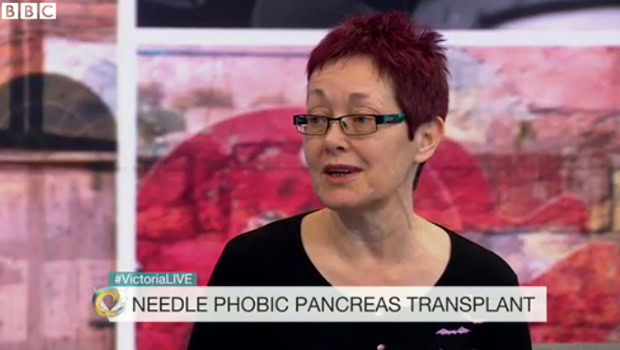Needle Phobia Leads to Pancreas Transplant

In the course of living with Type 1 diabetes for 38 years, Sue York of England developed a deep fear of needles. It was a phobia so severe that it caused her to shake and sometimes vomit when she injected insulin. Because of this, doctors eventually decided to undertake the world’s first-ever pancreas transplant in response to a phobia.
York, 55, explained in an interview with BBC’s Victoria Derbyshire Programme that she felt constantly afraid, even when she wasn’t directly using a needle. Because of this, she tried to find ways to avoid treating her diabetes more than absolutely necessary. When local rules were passed calling for people with diabetes to check their blood sugar levels before getting behind the wheel, for example, she simply stopped driving altogether.
A fear of needles, called trypanophobia, is said to affect approximately 10% of the population; the phobia can occur from birth or develop as a learned behavior after an unfavorable experience. Trypanophobia can be deadly for those living with Type 1 diabetes, as the anxiety associated with injections can cause people to forgo treatment.
York and her medical team exhausted other options before electing for the pancreas transplant, according to the report. She attempted cognitive behavioral therapy and hypnotherapy to ease her anxiety, but nothing worked.
Even once her team determined a transplant was the best option, it took over two years for her to be cleared for a transplant, a process that included three visits in front of a panel of doctors. Twenty-one days after being placed on the waiting list, she was matched with a donor. Now, after the success of the transplant, doctors say York’s life expectancy has doubled. She says her quality of life has dramatically improved.
There is fierce debate over whether York’s need was great enough to qualify for a transplant. Dr. Raman Dhanda of the Manchester Royal Infirmary defends the decision of the panel, explaining that there are strict guidelines both nationally and internationally to ensure that patients with the greatest need receive transplants first.
York’s story already has elicited strong opinions, both for and against the transplant, among the Type 1 community. Being a lightning rod of debate may be an unintended side effect of the transplant.
Thanks for reading this Insulin Nation article. Want more Type 1 news? Subscribe here.
Have Type 2 diabetes or know someone who does? Try Type 2 Nation, our sister publication.